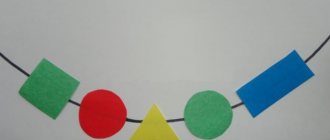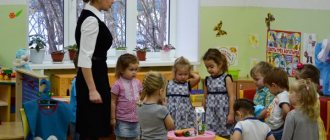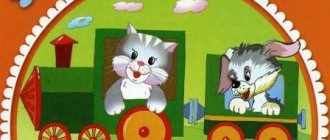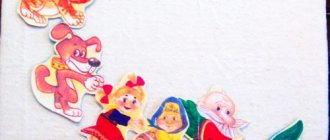Square. Big small. Left-right.
2 boxes of “Gnomes” to use
Summary of organized educational activities 2nd junior group “Dwarves”
Bookmark/Date:
16.10.2018.
Tarbieshi/ Educator:
Bokareva E. P.
I take salas/ educational area:
Cognition.
Pәn/ item:
FEMP.
Overall/ cross-cutting theme:
"My family".
Takyryby/topic:
Square. Big small. Left-right.
Maksattaras/goals:
formation of the concept of a square, the ability to recognize and name geometric shapes. Continue learning to compare two objects of contrasting length (short-long); continue to navigate on a sheet of paper (left-right); introduce the geometric figure – square; develop the ability to examine a square by tactile-motor means; trace the square by dots, understand that the square can be of different sizes (large or small), orient yourself on a sheet of paper; cultivate interest in drawing a new geometric figure.
Resurstarmen kamtamasyz etu / resource provision:
a square (large or small), one at a time, a workbook, red and blue pencils for each child.
Vocabulary work:
square.
Polygvaldyk component / polygval component:
tortburysh-square.
Ұyimdastarylgan oku қyzmetіnің Barysy – OUD:
1. Organizational moment :
A surprise moment.
(a bear in a box with a geometric figure - a square). Turns on a recording of the Bear roaring. He gets the children interested and asks: “Who is that roaring?” It seems he is roaring somewhere in our group, let's look for him. Show interest. They listen to the recording with a roar, they call it Bear.. - Oh, and Bear brought us something and takes out a geometric square figure from the box. Bear suggests remembering: -What geometric shapes do you already know? Together with the teacher, they find a box that moves, open it and take out a bear toy. Circle. -Do you want to get acquainted with a new geometric figure? Look, I brought you a square. Open your notebooks, find the same figure. They open their notebooks.
2. Negіzi bolіmі/main part:
Game “Circle the square”.
Working with a workbook (task 1, Fig. 1)
.
Invites us to consider a new geometric figure - a square.
They are considering. Vocabulary work:
square.
Repeat: square. Bilingual component:
square-tortburysh
.
Repeat: square-tortburysh.
Gives the task to move your finger along the arrows, as shown in the figure. Use a red pencil to circle a large square, and a blue pencil to circle a small square. Complete tasks. -Which square was circled with a red pencil? Big. -Which square was circled with a blue pencil? Small. -What is the name of the geometric figure that you circled? Square. Conducts individual work. Game “Guess First”
(Task 2, Fig. 2) Draws children’s attention to the drawing and says that these are two sisters, they are very similar, and only the most attentive children will be able to name and find the differences between the sisters. Look at the drawing. -What is the difference? One sister has short braids, and the other has long braids.
Physical education
Like clubfooted Misha, Let's all walk quietly, Then we'll walk on our heels. And then on your toes. Then we will walk faster and quickly start running.
Perform movements according to the text of the poem.
Game "Hint the path"
(task 3, Fig. 3)
.
He asks a riddle: He sleeps in a den in winter, under a huge pine tree, and when spring comes, He wakes up from sleep. They listen and guess the riddle. Bear. Mishka is happy that the riddle is about him. Mishka offers to find him in the picture, says that he loves honey. -Who is to the left of the bear? Bees. -What is to the right of the bear? A barrel of honey.
The bear asks the children: -Which direction should he go to find honey? Right. -And asks the children to draw a path from the bear to the barrel of honey. Draw a path from the bear to the barrel of honey.
3. Korytyndy / final part:
Mishka thanks the children for helping him get out of the box, helping him lead the path to the honey, and for this he gives them a geometric figure - a square. Show joy. Says goodbye and leaves. Say goodbye to the bear. -What new geometric figure did the bear give to the children? Square.
Math lesson notes “Magic Circle” 2 ml. gr.
Summary of a mathematics lesson in the second junior group on the topic: “Magic figure “Circle””
Integration of educational areas:
cognitive development, physical development, speech development.
Goal:
to create conditions for the formation of elementary mathematical concepts.
Consolidation and expansion of knowledge about geometric shapes. Objectives: Educational:
introduce a new geometric figure - a circle and its properties, continue to teach to see geometric figures in the shape of surrounding objects.
Strengthen the ability to compare a circle and a square by overlapping. Developmental:
develop attention, logical thinking, observation;
the ability to analyze, compare, and perform actions following the teacher’s model. Speech:
develop speech, analyze, compare, classify;
Educational
: cultivate interest in mathematical operations;
develop the ability to listen to the teacher and each other. Age group:
second youngest (age 3 years).
Material and equipment: Visual range:
circle, square figures, illustrations depicting objects similar to a circle.
Handout:
red and blue circles, red and blue squares.
Content of educational activities:
The teacher invites the children to guess
the riddle
: I have no corners And I look like a saucer, Like a plate and like a lid, Like a ring, like a wheel.
Who am I, friends? (Circle)
Look around! Draw a circle with your finger. The dolls were together in a row, and now they are sitting in a circle.
Our sun in the window is a golden circle in the sky. The round ball lies here, and it will rush into your hands.
Educator:
That's right guys, it's a circle.
Let's draw a circle in the air with our finger. Guys, what objects look like a circle? (Plate, hoop, wheel, clock). The teacher shows pictures depicting objects that look like a circle.
The circle has no corners, so it can be rolled. You have your own “circles” - roll them. Why are they rolling? (Round - children circle the office with their finger).
Finger game “Building a house”
Knock and knock, knock and knock - knocking is heard everywhere
(knock on fist)
We are building a house, a big house
(we show the roof of the house with our palms above our heads)
And with a porch and a chimney,
we put our palms together)
Smoke comes from the chimney,
(we show with lip movements smoke)
There is a lock on the door,
(hands in the lock)
Who could open it?
We twisted the lock, twisted it, pulled it, knocked it and opened it. (We perform movements with our hands according to the words)
Open the gate, Come all here.
(we spread our palms to the sides) Educator:
Guys, look who came to visit us?
- Little bear. - Look, the little bear brought a basket in which there are geometric shapes. The little bear wants to check how well you remember them.
The teacher takes a circle out of the basket.
— Guys, what is the name of this figure? - This is a circle. - Guys, what color is the circle? - Red. — Does the circle have corners? - No. It's round. - What can a circle do? - It's rolling.
The teacher shows how the circle rolls. And he offers the children to roll the circles that are on their tables.
The teacher takes out the next figure from the basket.
- Guys, what is the name of this figure - Square - What color is the square? - Blue. The teacher, using the technique of placing a circle on a square, draws the children’s attention to the fact that the square has corners.
- Guys, what does the square have? - Corners. — Is the square rolling? The teacher demonstrates to the children that the square does not roll. - No. - What do you think is stopping him? - Corners. The teacher invites the children to do the same. Using the technique of overlaying a circle on a square. Physical education minute.
- We are driving, driving, driving
(imitation steering wheel)
To distant lands.
Good neighbors, cheerful friends. (arms spread to the sides)
We have fun,
(clap hands)
We sing a song.
And the song says about how we live. Tra-ta-ta, tra-ta-ta (knocking hands on knees)
We are taking with us a cat -
(bends fingers)
Siskin, dog, cat, bully Monkey, parrot - Here!
hands") Game “Find the same figure” Educator:
- Guys, in front of you lie geometric figures - red and blue circles, blue and red squares. Now, whichever figure I will raise, you must also find the same one on your table, pick it up and name it.
Visual gymnastics:
“We played with the figures, our little eyes were tired. One, two, three, four, five, we’ll blink our eyes.
(blink)
Let them rest a little
(close their eyes)
And they will start blinking again.
(I open my eyes and blink) Summing up:
Guys, you were very attentive and friendly today. Did you like the game with the bear cub? - Yes. - The little bear says “Goodbye” to you, it’s time for him to go visit other guys, and he will come to visit us again. The children say goodbye to the bear cub and say “Goodbye” to him.
Lesson notes for the second junior group in mathematics: “Geometric Country”
Goal: Improve the ability to distinguish and name geometric shapes (circle, square, triangle).
Tasks:
- develop thinking: learn to see patterns in the arrangement of figures, reproduce them;
- develop attention and memory;
— to cultivate sense of purpose, the ability to finish a job, and the ability to act together.
Progress of the lesson
Children enter the room; in front of them on the floor is a path of geometric shapes cut out of colored cardboard.
Educator: Guys, today we are setting off along a magical path of geometric shapes, to a country where shapes live and everything around is made of them.
Children sit at tables, walking along the path.
Educator: You have found yourself in a country whose inhabitants have prepared several tasks for you, after completing which you will return home again. You are ready? (On the board in front of the children there are images of little men, on shirts there are geometric figures, as well as pictures of the figures.)
Children: Yes!
Educator: The first task is that there are a lot of figures in the country, but you will name and show only those with whom you are familiar. (Demonstration by the teacher of a colored circle, square, triangle) Now, show me exactly the same ones and the same color. (Children work with handouts). Well done, right! Tell me, how is the circle different from other figures, what can it do that other figures cannot?
Children: You can roll a circle; it does not have corners, like a circle and a square.
Educator: That's right, and you will learn another property of a circle by laying out figures from sticks. But before we start working with chopsticks, let's warm up and revive your fingers.
Finger gymnastics.
Our fingers ran
They galloped up the path,
We'll rest a little
Let's take the sticks together.
Children lay out geometric shapes from counting sticks and have difficulty laying out a circle.
Educator: Is it possible to make a circle out of sticks?
Children: No! But a square and a triangle are possible.
Educator: Yes. Guys, we are in a magical land, then lay out not just figures, but an image of an object, for example, a house, and name the figures that you used to build it.
Children: The roof is a triangle, the house is a square.
Educator: Correct. Now, pay attention! Not only by seeing, we can name, but even by touching, we will be able to recognize. One of the tasks of the inhabitants of the land of figures is the game of “Wonderful Bag”. A didactic game is played with flat geometric shapes, which children name by touch, placing their hand in the bag.
Educator: Well done, you also coped with this task. And now, residents invite you to play the game “Find your house.” Each figure lives in its own house, and when evening comes, it returns to the house on the door of which the corresponding figure is depicted. You, too, must find your house, and the figure in your hand will tell you who lives where. We play twice.
There are geometric shapes in hoops on the floor, and children hold the same ones made of colored cardboard in their hands. At the teacher’s command “day,” they jump, walk, and pretend to be different types of activities. On the command “night”, they take places in the circle, in accordance with the figure in their hand. After the game we sat down on chairs at the tables.
Educator: Spring is already coming, everything is becoming bright, colorful and therefore, your next task will be to revive the figures with color. You need to put the same shapes on the stencil cards, but only colored ones. (Children work with handouts.) Well done! Done! Our journey is over, you have completed the tasks of the inhabitants of the magical land, the path has been disenchanted, you can return back home!
Application:
Turlevskaya Oksana Anatolyevna, teacher of the MADOU No. 1 “Alyonushka”, Asino, Tomsk region, Russia.
The material is published in the author's edition
Project on FEMP in the second junior group “In the world of geometric shapes”
New physical education exercises, outdoor and didactic games were learned and mastered.
Children have improved fine motor skills and coordination of movements.
Systematic knowledge about geometric shapes was obtained.
Material used during the project:
Card index of didactic games
Game "Find the extra piece."
Children are shown one by one cards with images of geometric shapes (circle, square, triangle), asked to look at them and asked: “How are the shapes similar? How are the figures different? Which figure is the odd one out? Why?".
Game "Wonderful bag".
I am a wonderful bag
I'm a friend to all the guys.
I really want to know
How do you like to play?
The “wonderful bag” contains geometric shapes of different colors. Children identify geometric shapes by touch, then take them out and name the colors.
Game "Let's build a figure."
Children are asked to make a square or a triangle from sticks.
Game “Find an object of the same shape”
Children are asked to find objects of a certain shape in the environment - round, square, triangular;
Game "What does it look like"
Children are shown geometric shapes and asked to think and name what they look like, for example, the body of an animal, or a balloon.
Didactic game: “Decorate the mitten”
Target:
formation of skills to correctly name geometric shapes, development of visual memory, thinking, fine motor skills of the hands.
Materials:
mittens of different colors, cut out of cardboard, geometric shapes, cut out of cardboard.
Progress of the game:
The teacher shows the children mittens and invites them to decorate them. The child must choose a suitable geometric shape for the mitten.
Didactic game: “Geometric Lotto”.
Target:
developing children’s skills to compare the shape of a depicted object with geometric figures and select objects according to a geometric pattern.
Material:
5 cards depicting geometric shapes (circle, square, triangle), 5 cards each depicting objects of different shapes.
Progress of the game:
The teacher reviews the material with the children. Children name figures and objects. Then, according to the instructions of the teacher, they select cards with images of objects of the desired shape for their geometric samples. The teacher helps children correctly name the shape of objects (round, square, rectangular, oval, triangular).
Game "close the window".
Target
: select and correlate objects of two given shapes out of three.
Material
: for each child a plate with holes of two shapes, inserts of four different shapes - circles, triangles, squares.
Progress of the game
: The teacher tells the children that in front of them is an unusual house, with different windows, and draws attention to the shape. The windows can only be closed with liners of the same shape. Shows how to act correctly using words - like this, not like that, different. The teacher encourages children to use the method of dismembered examination of sensory properties when comparing inserts.




